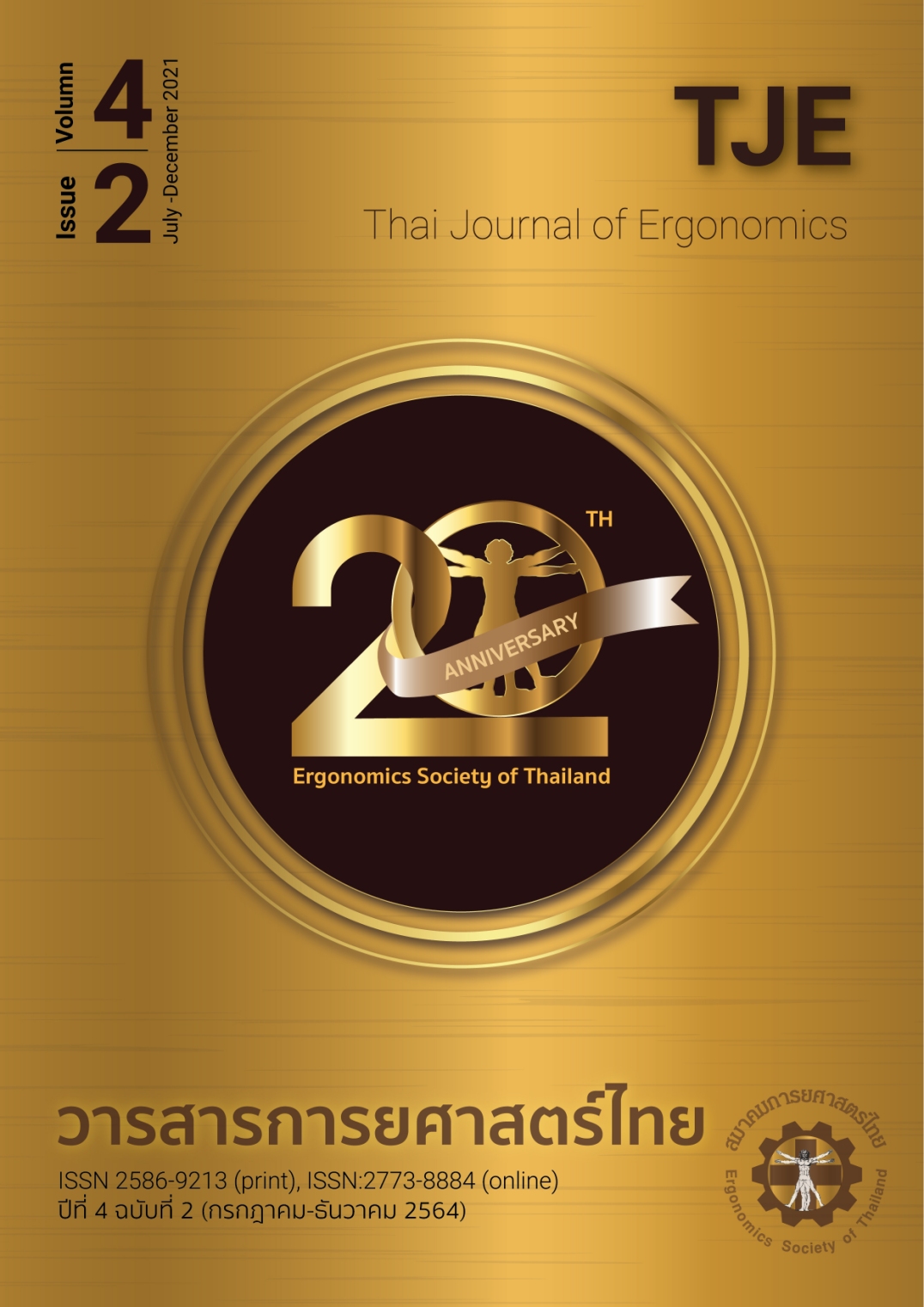Effects of back belt wearing and experience in back belt usage on maximum acceptable weight of lift in male workers: psychophysical approach
Main Article Content
Abstract
The purpose of this cross-sectional study was to investigate the effects of back belt wearing and experience in back belt usage on the maximum acceptable weight of lift (MAWOL) determined by psychophysical approach. Thirty male workers aged between 18-30 years old were recruited. Fifteen were non-experienced (NE) and the rests were experienced users (E) of back belts. MAWOL, heart rate (HR) and rating perceived exertion (RPE) at a lifting frequency of 4.3 times/min were determined. Back belt wearing and experience in back belt usage had significant effects on MAWOL. The results of the experiment found that back belt wearing can significantly increase MAWOL by 8.7 % and 12.0 % in the NE and the E group, respectively. The MAWOL of the E group was significantly higher than that of NE both in non-back belt (NB) and back belt wearing (WB) conditions. The E group had significantly lower heart rate than that of the NE group when MAWOL was determined. Even though, back belt wearing can increase weight of lift and decrease heart rate, these results should be used with cautions. Workers might have false senses of security which could lead to low back injuries.
Article Details
References
Riihimaki H. Low-back pain, its origin and risk indicators. Scand J Work Environ Health. 1991;17:81-90.
Snook SH, Irvine CH. Maximum acceptable weight of lift. Am Ind Hyg Assoc J. 1967;28:322-9.
Kraus JF, Schaffer KB, Rice T, Maroosis J, Harper J. A field trial of back belts to reduce the incidence of acute low back injuries in New York City home attendants. Int J Occup Environ Health. 2002;8:97-104.
Kraus JF, Brown KA, McArthur DL, Peek-Asa C, Samaniego L, Kraus C. Reduction of acute low back injuries by use of back supports. Int J Occup Environ Health. 1996;2:264-73.
Wassell JT, Gardner LI, Landsittel DP, Johnston JJ, Johnston JM. A prospective study of back belts for prevention of back pain and injury. JAMA. 2000;284:2727-32.
van Poppel MNM, de Looze MP, Koes BW, Smid T, Bouter LM. Mechanisms of action of lumbar supports: a systematic review. Spine (Phila Pa 1976). 2000;25:2103-13.
van Duijvenbode ICD, Jellema P, van Poppel MNM, van Tulder MW. Lumbar supports for prevention and treatment of low back pain. Cochrane Database Syst Rev. 2008;2008:CD001823.
McCoy MA, Congleton JJ, Johnston WL, Jiang BC. The role of lifting belts in manual lifting. Int J Ind Ergon. 1988;2:259-66.
Reyna JR, Jr., Leggett SH, Kenney K, Holmes B, Mooney V. The effect of lumbar belts on isolated lumbar muscle. Strength and dynamic capacity. Spine (Phila Pa 1976). 1995;20:68-73.
Lavender SA, Kenyeri RON. Lifting belts: a psychophysical analysis. Ergonomics. 1995;38:1723-7.
Peeradajmontree O. Maximum acceptable weight of lifting in Thai male workers age 18-30 years: psychophysical approach [Thesis]. Bangkok: Mahidol University; 2002.
Jackson AS, Sekula BK. The influence of strength and gender on defining psychophysical lift capacity. Proc Hum Factors Ergon Soc Annu Meet. 1999;43:723-7.
Häkkinen K, Newton RU, Gordon SE, McCormick M, Volek JS, Nindl BC, et al. Changes in muscle morphology, electromyographic activity, and force production characteristics during progressive strength training in young and older men. J Gerontol A Biol Sci Med Sci. 1998;53:B415-23.
Folland JP, Williams AG. The adaptations to strength training: morphological and neurological contributions to increased strength. Sports Med. 2007;37:145-68.
Bobick TG, Belard J-L, Hsiao H, Wassell JT. Physiological effects of back belt wearing during asymmetric lifting. Appl Ergon. 2001;32:541-7.
Marley RJ, Duggasani AR. Effects of industrial back supports on physiological demand, lifting style and perceived exertion. Int J Ind Ergon. 1996;17:445-53.
Rafacz W, McGill SM. Wearing an abdominal belt increases diastolic blood pressure. J Occup Environ Med. 1996;38:925-7.
Mital A, Foononi-Fard H, Brown ML. Physical fatigue in high and very high frequency manual materials handling: perceived exertion and physiological indicators. Hum Factors. 1994;36:219-31.


